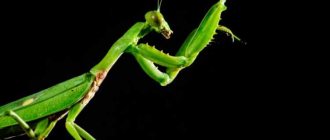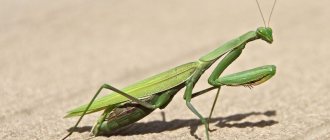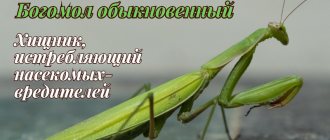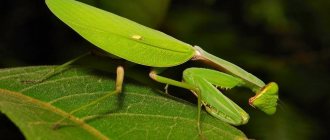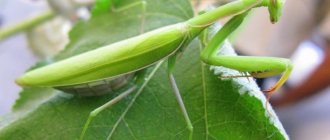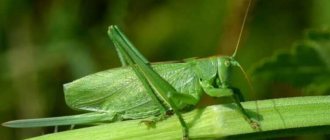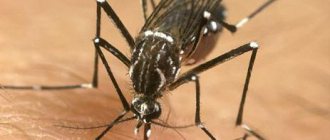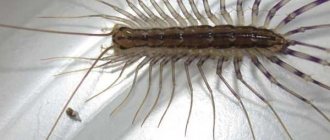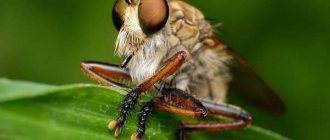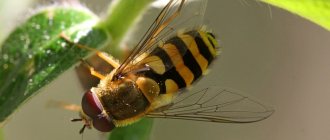- Wild animals
- >>
- Insects
The praying mantis is one of the strangest predatory insects on the entire planet. Some features of the life of an unusual creature, its habits, in particular its famous mating habits, may shock many. This insect is often found in ancient myths and tales of many countries. Some peoples attributed to them the ability to predict the coming of spring; in China, mantises were considered the standard of greed and stubbornness.
What it looks like: structure and characteristics of a praying mantis
Structure of a praying mantis
As a rule, praying mantises have an elongated body, which is a distinctive feature of these insects. Praying mantises are one of the few insects that can make a full rotation of their head around its axis . This is why they can easily spot enemies from behind. The insect has only one ear, but its hearing is excellent.
Mantis eyes
Mantises have compound eyes that are located on both sides of the head.
There are also three elemental eyes above where the antennae grow. The mantis' mustache, in turn, has a comb structure and can also be feathery and filamentous. The type of whiskers varies depending on the type of insect. Interesting fact : praying mantis is one of the varieties of wushu.
According to Chinese beliefs, this style was invented by a peasant who had been watching mantises hunt for a long time. Most varieties of mantises are equipped with wings, but only males can use them for their intended purpose. Females are unable to fly due to their large size and weight. Each insect has two pairs of wings - front and rear. They are usually brightly colored, sometimes with beautiful patterned designs. However, there is one species of mantis that has no wings at all - the ground mantis.
Mantis - structure and characteristics
Each mantis is well built and has developed front legs with which it can grab prey. The structure of the forelimbs is as follows: acetabular rings, femurs, tibiae with hooks at the ends, and paws. There are sharp spines on the lower part of the thighs, and there are also smaller spines on the lower leg.
Mantises clamp the caught food between their legs and thighs. They hold it until they eat it completely. Due to their unusual respiratory apparatus, praying mantises have the simplest circulatory system. Oxygen enters the insect's body through a complex chain of several tracheas, which are interconnected by stigmata.
Nutrition
It is no secret that our hero is a notorious predator who loves to feed on both smaller insects and is not afraid to attack larger prey even than himself. Flies eat them,
mosquitoes, bees, wasps, bumblebees, butterflies, beetles, etc. Large representatives of the praying mantis family (see above) can even attack small rodents, birds and small amphibians: frogs, lizards.
Mantises usually attack from an ambush, unexpectedly grab the prey with their front paws and do not let go until they have completely eaten it. Strong jaws allow these gluttons to eat even relatively large prey.
Dimensions
Ischnomantis gigas
The most important difference between the sexes is size. Females are much larger than males. The largest species of mantis, Ischnomantis gigas, lives in Africa; it can grow up to 17 cm in length, holding the record for its size among all mantises.
The second longest species of mantis is Heterochaeta orientalis. The record sizes of these representatives of mantises are slightly smaller - up to 16 cm. The simplest representatives of the species grow no more than 1.5 cm in length.
Interesting fact : in the USSR there was a plan according to which mantises could be used as protectors against agricultural pests. However, the idea was not realized, as predators killed the bees.
They have many predatory enemies
Praying mantises are a favorite food of frogs, lizards, birds, chameleons, spiders and hornets. Fire ants are a particularly formidable enemy. Because they work together, they have no problem killing the praying mantis. The insect's elongated forelimbs are not very useful against one ant, let alone dozens of individuals that secrete paralyzing poison. The fire ants freeze the mantis in place and devour it in a swarm, preventing it from escaping.
Since some of their most dangerous predators are birds, moving at night is safer for praying mantises. They even have a special organ that can pick up the echolocation calls of bats, helping them hide before they are eaten.
Habitat - where does the praying mantis live?
Habitat of the praying
mantis Mantises are distributed throughout the planet. They are in Europe, Asia, Africa and America. A wide variety of mantises have been recorded in Asian countries. A few species can be found in the CIS countries. Insects were also brought to Australia and North America, where they were able to take root.
Interesting: Why do midges often fly in swarms?
Praying mantises live in tropical and subtropical areas:
- In tropical rain forests.
- In hot deserts, where the merciless sun constantly bakes.
- In meadows and steppes, completely covered with thick grass.
The praying mantis is heat-loving.
By nature, praying mantises are heat-loving. They have a hard time withstanding low temperatures. Now in Russia you can find real invasions of mantises migrating from other countries. They are looking for food and new habitats.
Such migrations occur very rarely. Praying mantises prefer to live in already inhabited territories. They will stay in the same tree throughout their lives, as long as there is food there. Movements of insects are observed mainly during the mating season, when territories are depleted and when there is danger.
Habitats
Almost everywhere, since their habitat is very wide: Central and Southern Europe, Asia, North and South America, Africa, Australia. They are only absent in the northern regions, since mantises are not very accustomed to the cold. But they are perfectly suited, for example, to the hot and humid climate of tropical Africa and South America. Praying mantises thrive in tropical forests, steppe regions, and rocky deserts.
They rarely move from place to place, preferring their usual habitat to unknown distant places, the only reason that can prompt them to travel is the lack of food supply.
Why does a female praying mantis eat her husband?
During mating games, a female can eat her partner, confusing him with a potential victim. Also, females eat males for the reason that a lot of protein is required to bear offspring. In this case, not only partners are attacked, but also other representatives of the species.
Before mating, the male dances in front of his partner, releasing an odorous substance. The smell indicates that the insect belongs to the same genus. Sometimes the female may not eat the male, but this happens very rarely. First, the gentleman loses his head, and then the female completely eats him.
Predators also hunt very gracefully. They are quite maneuverable and can catch and kill a prey in a matter of seconds. A distinctive feature of insects is that they perfectly control all their movements in flight.
Pogonogaster tristani
The habitat of the beautiful praying mantis is the forests of Costa Rica. The species was discovered in 1918 and named after its discoverer, entomologist P. Tristani.
A rare species that is in no hurry to show itself to human eyes. In 2012, photographer Oscar Blanco was lucky to capture the insect. Later, together with zoologists, the photographer published an entire scientific work about this rare species, providing the work with beautiful pictures and photos.
And most-beauty.ru has prepared a fascinating article for you about the most unusual insects on the planet.
11
Color and camouflage
Praying mantises have excellent camouflage abilities. Their color and shape depend on the place of existence. Some mantises may be green, others brown, or even variegated. The color of an insect depends on its environment. Green mantises can be missed in the grass, brown ones on the ground. Variegated praying mantises look like this to attract females.
Color and camouflage of praying mantises
Color and camouflage of praying mantises
Color and camouflage of praying mantises
Color and camouflage of praying mantises
Color and camouflage of praying mantises
Some insects can have different shapes, masquerading as leaves. This way they become invisible to enemies. If someone attacks an insect, it begins to open its wings and try to look bigger.
№3
Mantises are an order of insects that are six-legged invertebrates with exoskeletons, segmented bodies and articulated legs. The main defining feature of praying mantises is their long, bent front legs. The insect holds these legs in a bent position under its head, as if it were praying (hence the name).
Types of mantises: photos and names
At the moment, there are approximately 2 thousand different species of these insects.
Interesting: Spiders - types of spiders, names, descriptions, photos and videos
Common mantis
Common mantis
Common mantises living in many countries of the world. They are quite large, reaching 7 cm in length. Mostly green or brown, can fly. The body of the insect is oblong. The main distinguishing feature of representatives of this species is a small black spot in the area of the coxae of the front legs.
Chinese mantis
Chinese mantis
Chinese mantises live in China. They are considered one of the largest. Females reach 15 cm in length. The main color is green, but they can also be brown. The young are wingless and can fly only when they grow up.
Creobroter meleagris
Creobroter meleagris
Creobroter meleagris, native to western Asia. Up to 5 cm in length. May be cream or white with brown stripes.
Indian flower mantis
Indian flower mantis
Indian flower mantises live in and near Indian territories. Very small - up to 4 cm. The body is slightly longer than the others, dotted with protective spines. Cream spots on the wings in the form of an eye. They live in flowers and catch insects that want to eat nectar.
Spiked flower mantis
Spiked Flower Mantis
The Spiked Flower Mantis lives in African countries. They are somewhat similar to the previous view. All wings are painted with interesting patterns, similar to eyes or spirals. They got their name from the spikes on their bellies.
Orchid mantis
Orchid mantis
Orchid mantises are one of the most beautiful species of these insects. They got their name due to their color and appearance, similar to orchid petals. They wait on these flowers and catch other insects. They grow up to 8 cm, while males are exactly half that size. The most fearless representatives of their family can rush even at large enemies.
Eastern heterochaete (HETEROCHAETA ORIENTALIS)
Eastern heterochaete (HETEROCHAETA ORIENTALIS)
Eastern heterochaete is one of the largest representatives of mantises. They can grow up to 15 cm in length. The majority of individuals live in Africa; they prefer to hide in the branches of bushes, so they are similar in appearance to them.
The forelimbs have spines
This is vital because its front legs are its main hunting tool. The praying mantis pounces on its prey with its fang-like forelimbs, intercepting it in just 50 to 70 milliseconds—about six times faster than the blink of an eye. The predator pierces the prey with its spikes, immobilizing it.
While most species have only a few spines, some have up to 30 spines. The thorns also help when jumping from one branch to another.
Photo: Hung Chei/Getty Images
Reproduction
Little praying mantises
Mating games end tragically for the males. The female rips off their head and completely eats the male. With the onset of mating games, males begin to leave their usual habitats in search of a female. At the same time, they look for a mate by the smell emitted by it. When the male finds a passion, he dances with the release of a special secret. Only after the dance will he be considered as a partner. The female does not kill her partner on a mere whim. This way she provides her offspring with a supply of nutrients.
Interesting fact : since ancient times, praying mantises have been attributed mystical significance; they have become heroes of various legends. So, in Asian countries, stubbornness and ruthlessness were attributed to praying mantises, and among the Greeks they were considered harbingers of spring.
Praying mantis egg laying
Sometimes the male can escape from an unsightly fate, but in this case the female can kill herself. When the female lays eggs, she completely covers them with a sticky substance secreted by special glands, this protects future offspring. Female mantises can lay up to 400 eggs, depending on their species. The eggs take up to six months to develop. The larvae can develop very quickly and after the fourth molt they become similar to praying mantises.
The female lays up to 400 eggs
Mantis eggs are laid in a foamy brown secretion called an ootheca, which becomes hard and protects the eggs from damage and predators. Most species die soon after laying eggs, but some can guard and protect the offspring before they hatch.
Photo: OLIVER KOEMMERLING/CC
Mantis eggs remain in the ooteca during the fall and winter and hatch as nymphs in the spring. Nymphs are very similar to adult mantises. They molt 5 to 10 times before reaching their adult size.
Why is the praying mantis called that?
The name praying mantis, established academically, first appeared in 1758. The insects were so named by the Swedish naturalist Carl Linnaeus. He observed the insects and made an interesting remark that they looked like people diligently praying to God. Indeed, the forelimbs of praying mantises seem to be folded in constant prayer. The insect was nicknamed "Mantis religiosa", which means "religious priest" in Latin. In the Russian interpretation, the name “mantis” has taken root.
Interesting: Why don’t moths stop flying towards fire?
Carl Linnaeus was the first to scientifically describe the praying mantis
At the same time, the insect is not called a praying mantis in all corners of the planet. Mystical meanings are often attributed to praying mantises. In Spain, for example, the praying mantis is associated with death and is nicknamed the devil's horse. Such names can be associated with the cruel habits of mantises, which terrify people.
Video
And in conclusion, we bring to your attention an interesting popular science film about praying mantises.
Author: Pavel Chaika, editor-in-chief of Poznavaika magazine
When writing the article, I tried to make it as interesting, useful and high-quality as possible. I would be grateful for any feedback and constructive criticism in the form of comments on the article. You can also write your wish/question/suggestion to my email [email protected] or Facebook, with respect, the author.
Author page
This article is available in English -
Praying Mantis – an Alien Insect.
Population and species status
Numerous populations of mantises are gradually decreasing. However, this feature is characteristic only of insects in the European part of the world. In African and Asian countries, praying mantises continue to breed. Great harm to populations is caused not by their natural enemies, but by human activity. People are destroying the natural habitats of mantises, cutting down forests and destroying fields. Sometimes there are situations when one type of mantis displaces another from certain territories. Sometimes genocide occurs, since praying mantises are very voracious.
Since insects are predominantly heat-loving, they do not reproduce well in cool areas. The larvae also develop more slowly, so complete restoration of the population takes a lot of time. Old generations have time to die out before new ones appear. To preserve the population, people try to minimize the damage caused by human activity to the environment.
Blepharopsis mendica
The calm, non-aggressive insect is also called the “devil’s flower” due to its color and body structure. It was discovered by the scientific world in 1775 by the Danish zoologist Johann Sebastian Fabricius.
At the moment of danger, they spread their wings wide and raise their limbs to scare away the enemy. They live in semi-desert and mountainous regions of Southeast Asia and northern Africa.
7
Benefits and harms for humans
Despite their aggressive behavior, praying mantises do not pose a danger to humans . Even despite the large size of some members of the family.
Mantis Spikes
The only harm a praying mantis can do to an adult is to injure it with its claws. For this reason, you should not allow small children near praying mantises . The character of insects is far from ideal.
Predators are useful for agriculture as they eat many agricultural pests. In Africa, praying mantises are brought into houses where they eat flies. However, praying mantises are insatiable - they can destroy beneficial insects like bees.
№10
They go through three life cycle stages: egg, nymph and adult. Unlike a number of other insects, praying mantises do not have a pupal stage.
Representatives of small species can be born within 3-4 weeks after laying eggs, larger ones - after 4-6 weeks.
A baby (nymph) emerges from the egg, which is practically no different from the adult (except for the ability to fly and reproduce).
As the nymph reaches the adult stage, it can change up to 10 exoskeletons (molt).
We also recommend reading: Interesting facts about peacocks
Keeping praying mantises at home
Terrarium for a praying mantis
Praying mantises are suitable for keeping in terrariums. They are taken into homes where they are given proper care. The most comfortable conditions for keeping praying mantises are:
- Temperature range – 20-30 degrees Celsius.
- Humidity levels of the terrarium are at least 60%.
There is no need to feed insects; they get everything they need from food. In the wild, small species of mantises are replaced by stronger and larger ones, and sometimes complete extermination of a species in a certain area can occur.
For praying mantises, special conditions need to be prepared. The decision to get such an exotic pet can be considered a very interesting act on the part of a person. The terrarium does not need to be large. Praying mantises only need a small area in the form of a plastic or glass container. The lid of the terrarium should be made of mesh, and its dimensions should accommodate at least three more such mantises. It is better to add twigs or plant plants in a terrarium. This way the insect will be able to climb on them as in natural conditions.
As mentioned earlier, praying mantises prefer a humid environment with a temperature of 20 to 30 degrees Celsius. They feed on other insects. On sale in pet stores you can find various bugs and ants that will become live food for the praying mantis. Feeding should be regular, but praying mantises do not need a drinking bowl.
Choeradodis rhombicollis
This unusual insect lives in mountainous Peru. The shield mantis is very difficult to see among green foliage, as it is easily disguised as green leaves and shoots of plants.
In total, the genus Choeradodis includes 5 species, differing in size and body structure. Some species from Peru moved to Central America, easily adapting to new living conditions.
10

